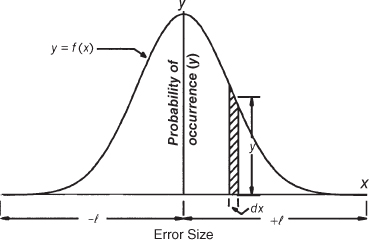APPENDIX DTHE NORMAL ERROR DISTRIBUTION CURVE AND OTHER STATISTICAL TABLES
D.1 DEVELOPMENT FOR NORMAL DISTRIBUTION CURVE EQUATION
In Section 2.4, the histogram and frequency polygon were presented as methods for graphically portraying random error distributions. If a large number of these distributions were examined for sets, observations in surveying, geodesy, and photogrammetry, it would be found that they conform to normal (or Gaussian) distributions. The general laws governing normal distributions are stated as follows:
- Positive and negative errors occur with equal probability and equal frequency.
- Small errors are more common than large errors.
- Large errors seldom occur, and there is a limit to the size of the greatest random error that will occur in any set of observations.
A curve that conforms to these laws is plotted with the size of the error on the abscissa and probability of occurrence on the ordinate, appears as Figure 3.3. This curve is repeated on Figure D.1 and is called the normal distribution curve, the normal curve of error, or simply the probability curve. A smooth curve of this same shape would be obtained if for a very large group of observations, a histogram were plotted with an infinitesimally small class interval. In this section, the equation for this curve is developed.

FIGURE D.1 The normal distribution curve.
Assume that the normal distribution ...
Get Adjustment Computations, 6th Edition now with the O’Reilly learning platform.
O’Reilly members experience books, live events, courses curated by job role, and more from O’Reilly and nearly 200 top publishers.

